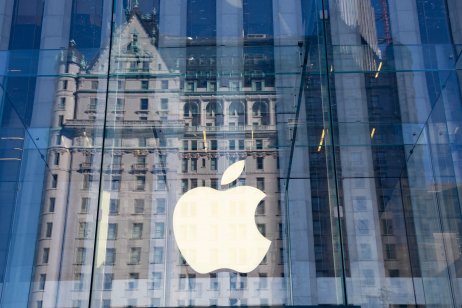How Much Will Apple Stock Be Worth In 10 Years?
February 8, 2025

US technology giant Apple (AAPL)’s share price has come a long way over the past four decades. What do the next 10 years have in store? The innovative firm replaced ExxonMobil as the world’s largest company in 2011, and became the first trillion-dollar public company seven years later. But where will it go next? Technology moves rapidly, so the question for investors is whether Apple can stay one step ahead of its fierce competition.
In this Apple long-term stock forecast, we look at how the company makes its money, outline its plans for the future, and ask how much Apple stock will be worth in 10 years’ time.
Apple stock price forecast for 2025
The Apple price forecast for 2025, as of 22 January 2025, includes a consensus from 35 Wall Street analysts compiled by MarketBeat. The average price target for Apple’s stock over the next 12 months is $237.99, reflecting an anticipated 7.26% increase from the current share price. Price targets range between a high of $325.00 and a low of $180.00.
Wedbush analyst Daniel Ives is at the top of that range, having increased the stock’s price target to $325, up from $300, while maintaining an Outperform rating on the stock. The firm anticipates Apple is entering a multi-year AI-driven iPhone upgrade cycle, a trend it believes is currently undervalued by the broader market.
Analyst Edison Lee offers a contrasting view, downgrading Apple to ‘underperform’ as reported by Barron’s. Lee’s price target of $200.75 is based on concerns over weak iPhone demand and subdued consumer interest in AI features.
Meanwhile, J.P. Morgan maintains an ‘overweight’ rating but adjusts its price target to $260, citing macroeconomic headwinds, including a strong dollar and flat unit sales.
While short-term forecasts present a mixed picture, long-term predictions remain speculative. Market sentiment continues to reflect optimism in Apple’s ability to leverage AI and service revenue for sustained growth. Always conduct your own due diligence and consider your risk tolerance and investment goals before trading.
Long-term prediction: where might Apple stock be in 10 years?
Any long-term prediction of the Apple stock price over 10 years is always going to be highly speculative, but according to Tradersunion.com, the price of the stock by January 2035 could be $772.40.
Moving back to within a range of five years, CoinCodex projects a maximum price of $400.83 per share in January 2030. And moving further afield still to 2040, the same site makes a prediction as high as $785.67 for January of that year.
What factors drive the price of Apple stock?
The price of Apple stock is shaped by a combination of strategic initiatives, industry trends, macroeconomic conditions, and competitive pressures. As a global tech leader, Apple’s decisions and external influences often resonate throughout the market. Below are some of the most critical factors influencing its share price.
Future strategy and innovation
Apple’s focus on innovation remains a key driver of its stock price. The company’s expansion into augmented reality and artificial intelligence (AI) technologies, particularly through products like the Vision Pro headset and potential AI integration across its ecosystem, signals efforts to remain ahead of technological trends. Investors closely monitor these developments, as successful product launches often correlate with increased revenue and positive stock performance.
Industry trends: AI
AI has become a central theme in the tech industry, and Apple is strategically adopting AI to enhance user experiences, such as improving Siri or implementing machine learning in iPhone cameras. However, Apple’s relatively cautious approach compared to competitors like Microsoft or Alphabet could influence perceptions of its long-term AI strategy. Additionally, the broader shift toward sustainable technology impacts Apple’s supply chain and product design, appealing to environmentally conscious investors.
Supply chain and labour challenges
As a hardware-driven company, Apple’s reliance on complex global supply chains introduces vulnerabilities. Fluctuations in the availability of raw materials, semiconductor shortages, and rising labour costs in key manufacturing regions like China can affect production timelines and profitability. Similarly, geopolitical tensions, such as US-China trade relations, often create uncertainty around Apple’s operations and stock performance.
Expansion into new markets
Apple’s rumoured ambitions in the automotive industry, potentially via an electric vehicle (EV) project, represent a bold move that could reshape its growth trajectory. Likewise, its ongoing investment in streaming services through Apple TV+ reflects its efforts to diversify revenue streams. Success in these markets could provide significant long-term upside for its stock, while challenges in gaining a foothold could weigh on investor confidence.
Macroeconomic factors
Apple’s stock price is also tied to macroeconomic indicators like inflation, interest rates, and consumer spending. During periods of high inflation or weak economic growth, demand for premium devices like iPhones or Macs may decline. On the other hand, favourable economic conditions and increased disposable income can boost sales and, consequently, Apple’s valuation.
Market competition and regulation
Rising competition from companies such as Samsung, Google, and emerging Chinese brands adds pressure on Apple to maintain its dominance, particularly in the smartphone and wearables markets. Additionally, regulatory scrutiny over data privacy and App Store policies could impact the company’s bottom line, as legal battles and compliance measures may incur additional costs or restrict operations.
By keeping an eye on these factors, investors can better understand the dynamics behind Apple’s stock movements and the company’s potential for future growth.
Apple (AAPL) price history
Past performance is not a reliable indicator of future results.
Apple went public on 12 December 1980 at $22 per share, equivalent to $0.10 on a split-adjusted basis after five stock splits. Since then, the company has become a cornerstone of the tech industry, achieving milestones that reflect its remarkable growth.
Key milestones in Apple’s stock history
1980-1990s: Apple established itself as a major player in personal computing, but its stock remained relatively modest compared to its later trajectory.
2000-2010: the launch of the iPod and iPhone marked a transformative period. Apple became a cultural icon, and its stock began a steady climb.
2014: Apple became the first publicly traded company to hit a market capitalisation of $700 billion.
August 2020: Apple executed its most recent stock split (4-for-1), making shares more accessible to retail investors.
Apple’s share performance after the latest stock split
Since the 2020 split, Apple’s stock has demonstrated consistent growth. Shares rose from around $125 shortly after the split to a then all-time-high above $180 on 3 January 2022. This marked the culmination of Apple’s extraordinary growth during the tech boom.
However, 2022 was challenging, with a 27% decline in stock value as broader economic conditions weighed on tech stocks. By contrast, 2023 saw recovery, with shares gaining 48% year to date by year-end.
Recent performance and current value
As of 21 January 2025, Apple’s stock price stands at $221.85, representing a strong rebound and continued investor confidence. The company remains one of the most valuable in the world, with a market capitalisation surpassing Alphabet (GOOGL) and Amazon (AMZN) combined.
Over the past 15 years, meanwhile, the company has achieved trailing returns of 22.39% – ahead of the 25.76% recorded by the industry, according to Morningstar data to the same date.
Apple share trading strategies to consider
Apple’s stock is one of the most closely watched in global markets, reflecting the company’s role as a leader in technology and innovation. With its consistent growth, diverse revenue streams, and influence on the broader tech sector, Apple presents unique dynamics for traders.
To navigate these opportunities effectively, a clear strategy is essential. Whether it’s leveraging key market events or analysing long-term trends, aligning your approach with Apple’s distinctive characteristics can help you make more informed decisions.
1. Position trading: longer-term strategy
Position trading involves holding a stock over an extended period to benefit from sustained price movements. For Apple, this often means focusing on its strong fundamentals, such as robust cash flows, innovative product releases, and global market share.
Apple’s recurring revenue streams, like its growing services segment (eg, iCloud, Apple Music), and periodic product cycles (eg, new iPhone or Mac launches) make it potentially attractive for longer-term positions. Fundamental analysis, including discounted cash flow (DCF) or valuation multiples, can help assess its intrinsic value.
Consider using key metrics like services revenue growth or hardware sales trends to evaluate long-term potential.
2. News trading: reacting to market events
Apple is a company that regularly moves the market with news, making it a potential choice for a news-driven trading strategy. Key triggers include product launches, earnings announcements, and regulatory developments, such as antitrust rulings or supply chain disruptions.
For instance, monitoring events like the annual Apple Worldwide Developers Conference (WWDC) or product reveal events can provide actionable insights. Additionally, supply chain news (eg, chip shortages or new supplier partnerships) often impacts Apple’s share price.
Utilise real-time alerts and tools to stay updated, and prepare to act swiftly during these events.
3. Trend trading: riding the momentum
Trend trading focuses on identifying and following established price movements. Apple’s shares often display clear trends tied to its earnings cycles, broader tech sector momentum, or macroeconomic factors like interest rate changes that affect growth stocks.
Traders can combine technical indicators like moving averages, the relative strength index, or MACD with Apple-specific fundamental drivers. For instance, if a new product launch is received positively, it could reinforce an upward trend.
4. Day trading: intraday opportunities
Apple’s high liquidity, tight bid-ask spreads, and sensitivity to news make it a favourite among day traders. Intraday strategies often focus on earnings days or periods of high market volatility.
You might consider using tools like level 2 order books and real-time charts to spot opportunities. Monitoring the US Tech 100 and tech-heavy indices can also provide context for Apple’s intraday moves, as its share price often correlates with broader tech sector trends.
Additional Apple trading insights
- Diversify your strategies: instead of relying on a single approach, consider a mix of strategies based on market conditions. For instance, position trading might work well in a bullish market, while trend trading can be effective in volatile conditions.
- Risk management is key: set clear stop-loss levels and position sizing rules to protect your capital. Even the most effective strategies can lead to losses without proper risk controls.
- Stay educated: regularly update your knowledge of market trends, economic indicators, and sector performance. Enrolling in share trading courses or following expert analysts can deepen your expertise.
FAQs
What will Apple stock be worth in 10 years?
Is Apple stock a buy right now?
Is Apple a good long-term investment?
Markets in this article
Related topics
Search
RECENT PRESS RELEASES
Related Post



